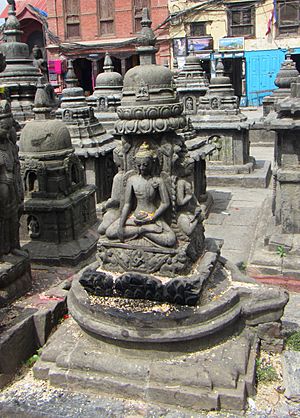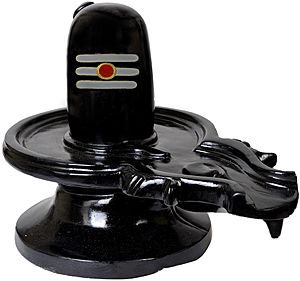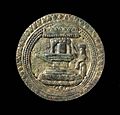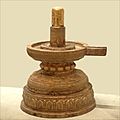Lingam facts for kids
A linga or lingam is a special symbol in Hinduism. It is mostly linked with Shiva, who is a very important god in the Hindu religion. Ancient Hindu writings say that a linga stands for energy and strength. In most temples dedicated to Shiva, he is shown in the form of a linga.
Hindu scriptures also mention that Shiva appeared in twelve special forms called Jyotirlinga. This means a linga of light. In India, there are twelve places where people worship Shiva in this form.
The scriptures also talk about five other forms of lingas. These represent the five main elements: earth, water, fire, air, and sky (or ether). There are five different places in India where Hindus worship Shiva in these elemental forms. These places are:
- Kanchipuram: Shiva’s linga in the form of the earth.
- Srirangam: Shiva’s linga in the form of the water.
- Tiruvannamalai: Shiva’s linga in the form of the fire.
- Kalahasti: Shiva’s linga in the form of the air.
- Chidambaram: Shiva’s linga in the form of the sky (or ether).
Besides these important places, you can find Shiva temples in almost every town and village in India. In all these temples, lingas are worshipped.
Worship and Materials
Traditional rituals for the lingam in Shiva temples include many offerings. People offer flowers, grass, dried rice, fruits, leaves, and water. They also give the lingam a milk bath.
In Hindu tradition, some special pilgrimage sites have natural lingams. These are found as cylindrical rocks, ice formations, or rocky hills.
A lingam can be made from different materials. It might be made of clay (mrinmaya) or metal (lohaja). Some are made of precious stones (ratnaja) or wood (daruja). Stone (sailaja) is the most common material. Sometimes, they are made from materials that can be disposed of (kshanika).
Tallest Lingam
The tallest Shiva lingam in the world is located in Chenkal village. This village is in the Thiruvananthapuram district of Kerala, India.
Images for kids
-
Lingam as interpreted in the Shaiva Siddhanta tradition, a major school of Shaivism. The upper and lower parts represent Parashiva and Parashakti perfections of Lord Shiva.
-
Lingam from Angkor period on display at the National Museum of Cambodia. Discovered in Battambang Province (Cambodia), it is made of bronze, quartz and silver.
-
8 faced Shivlingam in Pashupatinath Temple at Mandsaur, Madhya Pradesh
-
Sixty four lingams (Nepal)
-
Lingam from Angkor period, Battambang Province (Cambodia)
-
Linga-yoni, Java (Indonesia)
-
Copper lingam at the Cát Tiên sanctuary, Vietnam
-
A lingam at the Katas Raj Temples in north Pakistan
See also
 In Spanish: Lingam para niños
In Spanish: Lingam para niños























